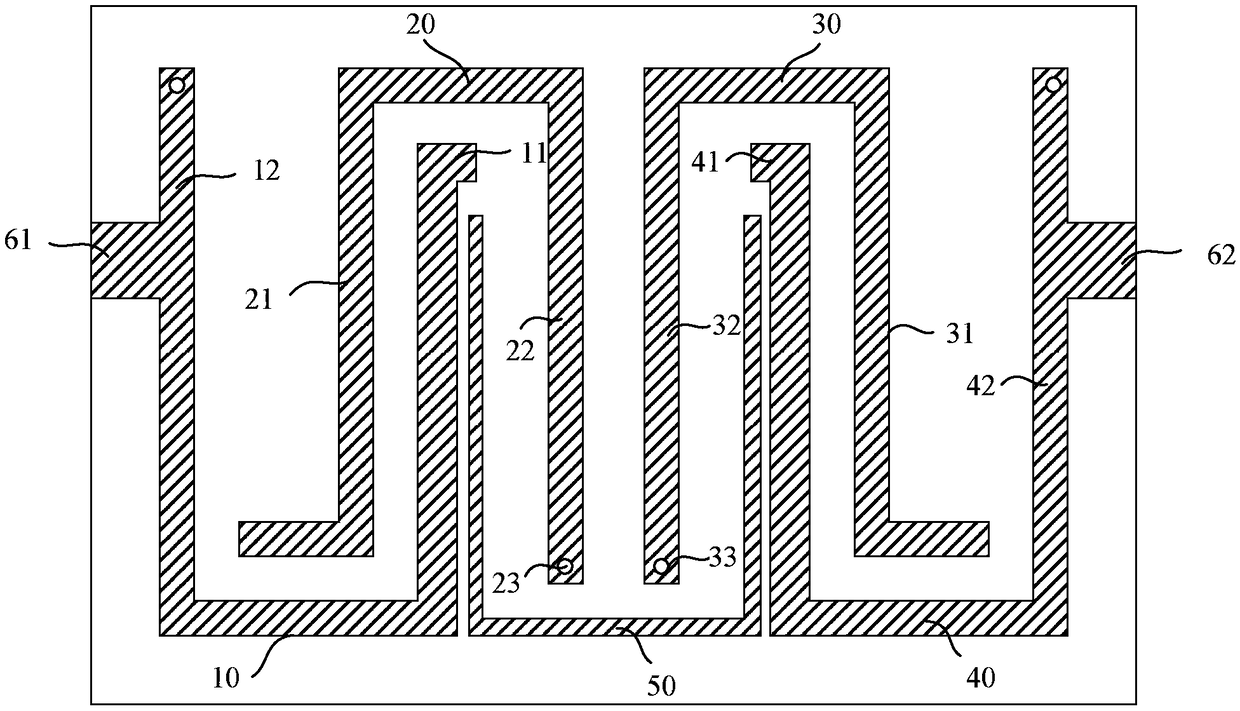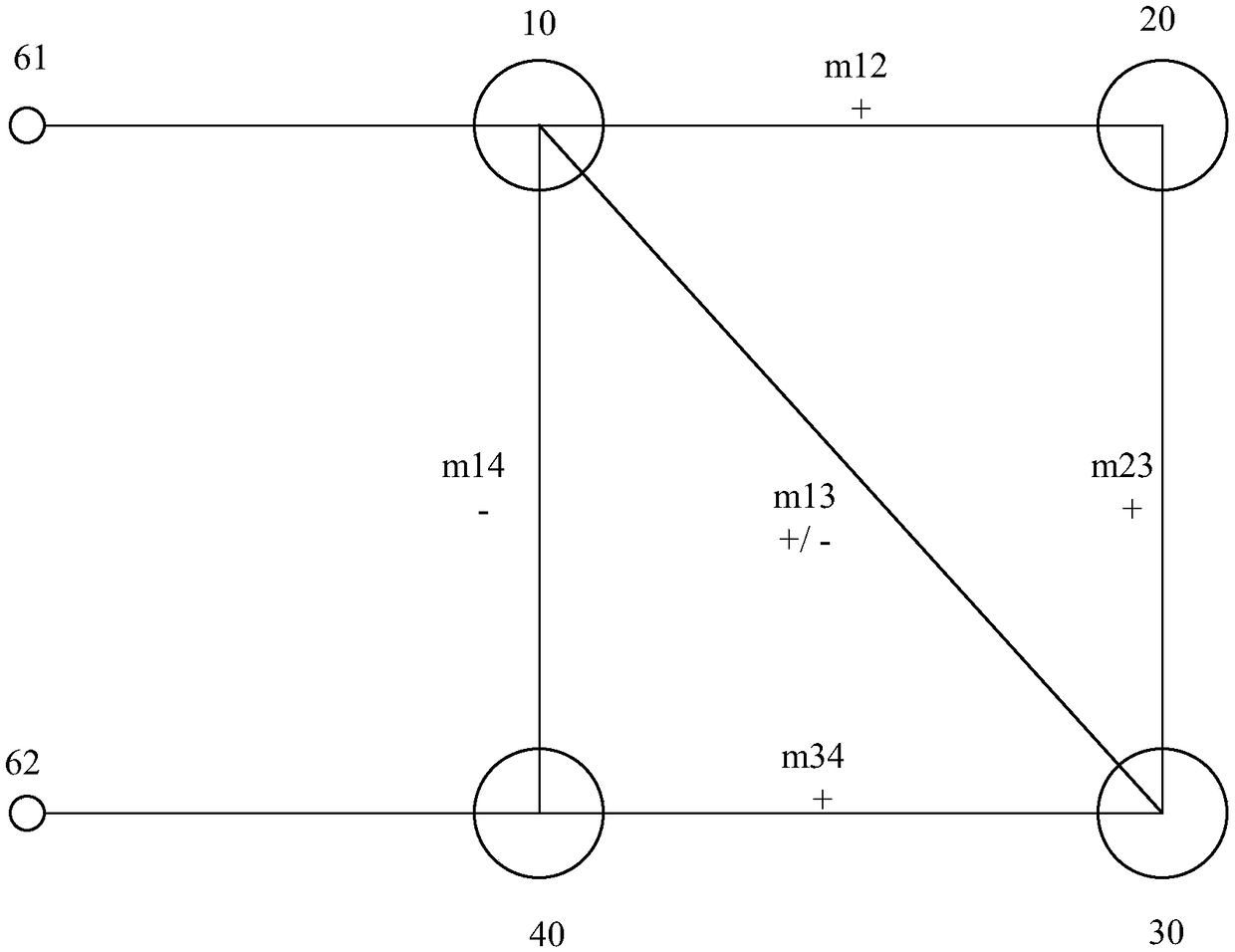A microstrip bandpass filter
A band-pass filter and filter technology, applied in the field of filters, can solve the problems of large filter volume, unfavorable integration, affecting filter suppression, etc., and achieve low insertion loss, miniaturization, and large out-of-band suppression. Effect
- Summary
- Abstract
- Description
- Claims
- Application Information
AI Technical Summary
Problems solved by technology
Method used
Image
Examples
Embodiment 1
[0058] figure 1 A schematic structural diagram of the first embodiment of the present invention is presented in figure 1 As shown, the opening directions of the first resonance unit 10 and the fourth resonance unit 20 are the same; the opening directions of the second resonance unit 20 and the third resonance unit 30 are the same and opposite to the opening direction of the first resonance unit 10 .
[0059] The short-circuit point 23 of the second resonance arm 22 of the second resonance unit 20 is adjacent to the short-circuit point 33 of the second resonance arm 32 of the third resonance unit 30 .
[0060] Wherein, both ends of the cross-coupled microstrip line 50 are respectively coupled with the first resonance unit 10 and the fourth resonance unit 40, and both ends of the cross-coupled microstrip line 50 are open circuits, so as to generate two Transmit zero.
[0061] Specifically, both ends of the cross-coupled microstrip line 50 are respectively coupled with the firs...
Embodiment 2
[0064] Figure 4 A schematic structural diagram of a second embodiment of the present invention is presented in Figure 4 As shown, the opening directions of the first resonance unit 10 and the third resonance unit 30 are the same; the opening directions of the second resonance unit 20 and the fourth resonance unit 20 are the same and opposite to the opening direction of the first resonance unit 10 .
[0065] The short-circuit point 23 of the second resonance arm 22 of the second resonance unit 20 and the short-circuit point 33 of the second resonance arm 32 of the third resonance unit 30 are away from each other.
[0066] The two ends of the cross-coupled microstrip line 50 are respectively coupled with the first resonance unit 10 and the third resonance unit 30, and both ends of the cross-coupled microstrip line 50 are open circuits to generate two transmission zeros at low frequencies.
[0067] Specifically, both ends of the cross-coupled microstrip line 50 are respectivel...
Embodiment 3
[0070] Figure 7 A schematic structural diagram of a second embodiment of the present invention is presented in Figure 7 As shown, the opening directions of the first resonance unit 10 and the third resonance unit 30 are the same; the opening directions of the second resonance unit 20 and the fourth resonance unit 20 are the same and opposite to the opening direction of the first resonance unit 10 .
[0071] The short-circuit point 23 of the second resonance arm 22 of the second resonance unit 20 and the short-circuit point 33 of the second resonance arm 32 of the third resonance unit 30 are away from each other.
[0072] Wherein, both ends of the cross-coupled microstrip line 50 are respectively coupled with the second resonance unit 20 and the fourth resonance unit 40, and both ends of the cross-coupled microstrip line 50 are short-circuited to generate two transmission zeros at high frequencies .
[0073] Specifically, both ends of the cross-coupled microstrip line 50 ar...
PUM
 Login to View More
Login to View More Abstract
Description
Claims
Application Information
 Login to View More
Login to View More - R&D
- Intellectual Property
- Life Sciences
- Materials
- Tech Scout
- Unparalleled Data Quality
- Higher Quality Content
- 60% Fewer Hallucinations
Browse by: Latest US Patents, China's latest patents, Technical Efficacy Thesaurus, Application Domain, Technology Topic, Popular Technical Reports.
© 2025 PatSnap. All rights reserved.Legal|Privacy policy|Modern Slavery Act Transparency Statement|Sitemap|About US| Contact US: help@patsnap.com



